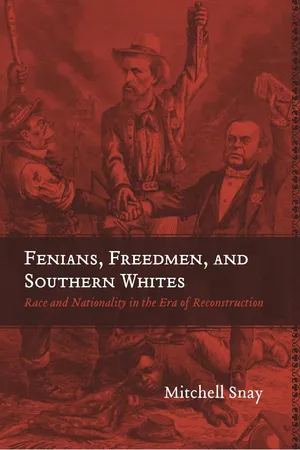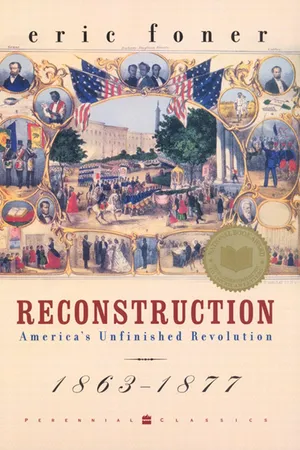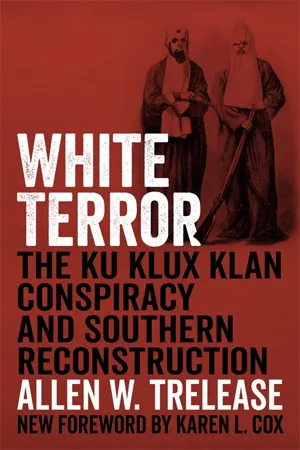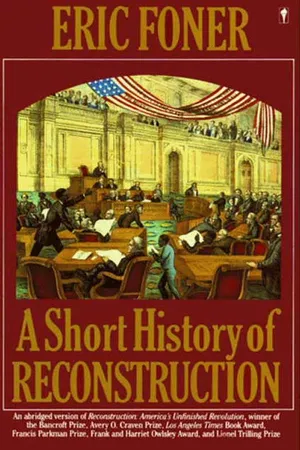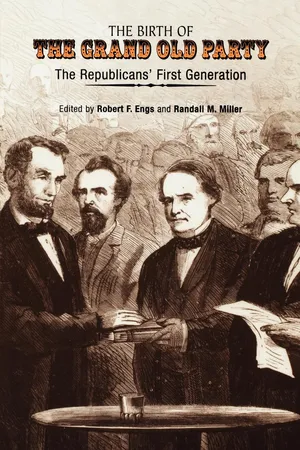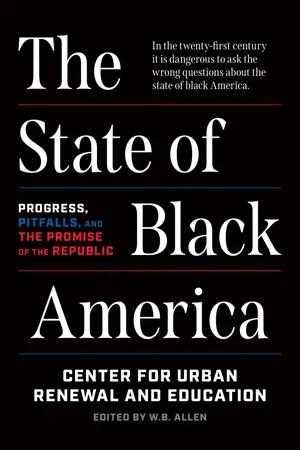History
Radical Republicans
The Radical Republicans were a faction of the Republican Party during the American Civil War and Reconstruction era. They advocated for the abolition of slavery, civil rights for freed slaves, and harsh punishment for the Confederacy. They played a significant role in shaping Reconstruction policies and pushing for social and political change in the South.
Written by Perlego with AI-assistance
Related key terms
8 Key excerpts on "Radical Republicans"
- eBook - ePub
Fenians, Freedmen, and Southern Whites
Race and Nationality in the Era of Reconstruction
- Mitchell Snay(Author)
- 2010(Publication Date)
- LSU Press(Publisher)
16Many southerners saw northern Republicans as a revolutionary party. At the beginning of Congressional Reconstruction, the Natchez Democrat noted that the Republican Party was organizing “with that rapidity of action which usually characterizes the movements of revolutionary organizations.” In attempting to define “Radicalism,” an Arkansas Democratic editor feared that the Republican Party was “now a few steps removed from anarchy, in its utter disregard of all law and precedent, the only right recognized being that of might.” Conservative southern whites drew analogies between Republican Reconstruction and the excesses of the French Revolution. The Mobile Daily Advertiser and Register referred to Republicans as “Jacobin tyrants.” One frightened southerner spoke in fear of a “reign of Terror,” explaining that “The party of Robespierre, Danton, and Marat has set the example in history, and there is no greater truth than that history repeats itself.” Several southerners observing Republican legislatures drew on this analogy. A Kentuckian who witnessed the debate over the Fourteenth Amendment in the House of Representatives compared the scene to the French Revolution. In Mississippi, former fire-eater Albert Gallatin Brown saw “the disembodied spirit of Danton Marat and Robespierre Stalking in the Senate Chamber.” Since many of the above comments came from personal correspondence, the metaphor of the French Revolution served not only to discredit Republican Reconstruction but to express the seemingly real fears of a world being turned upside down.17Southern whites insisted that the imposition of Radical Reconstruction on the South amounted to military oppression. “The Southern States,” maintained the Milledgeville Recorder, “were never before divested of everything and placed under military despotism.” The Reconstruction Acts, according to one Texas newspaper, were “so framed as to make the military officer of each district a complete dictator.” Looking back from 1869, an Arkansas editor complained that the Radicals in the South had “stifled free speech, muzzled the press, trampled on the Constitution, suspended the writ of habeas corpus, quartered troops in the States without their consent, taxed the people without the correlative right of representation, passed ex post facto laws, and showed a perfect disregard of all fundamental laws and precedents.”18 - eBook - ePub
- Eric Foner(Author)
- 2011(Publication Date)
- Harper(Publisher)
The Making of Radical ReconstructionI T was a peculiarity of nineteenth-century politics that more than a year elapsed between the election of a Congress and its initial meeting. The Thirty-Ninth Congress, elected in the midst of war, assembled in December 1865 to confront the crucial issues of Reconstruction: Who would control the South? Who would rule the nation? What was to be the status of the emancipated slave? In both Houses, Republicans outnumbered Democrats by better than three to one. Clearly, a united party would have no difficulty enacting a Reconstruction policy and, if necessary, overriding Presidential vetoes. But American parties are not tightly organized, ideologically unified political machines, and the interaction between the Republican party’s distinctive factions would go a long way toward determining the contours of Congressional policy.The Radical Republicans
On the party’s left stood the Radical Republicans, a self-conscious political generation with a common set of experiences and commitments, a grass-roots constituency, a moral sensibility, and a program for Reconstruction. At the core of Congressional Radicalism were men whose careers had been shaped, well before the Civil War, by the slavery controversy: Charles Sumner, Ben Wade, and Henry Wilson in the Senate; Thaddeus Stevens, George W.Julian, and James M. Ashley in the House. With the exception of Stevens they represented constituencies centered in New England and the belt of New England migration that stretched across the rural North through upstate New York, Ohio’s Western Reserve, northern Illinois, and the Upper Northwest. Here lay rapidly growing communities of family farms and small towns, where the superiority of the free labor system appeared self-evident, antebellum reform had flourished, and the Republican party, from the moment of its birth, commanded overwhelming majorities. - eBook - ePub
White Terror
The Ku Klux Klan Conspiracy and Southern Reconstruction
- Allen W. Trelease(Author)
- 2023(Publication Date)
- LSU Press(Publisher)
73The Radical revolution, as some contemporaries on both sides regarded it, was only a halfway revolution. Within the South, Radical Reconstruction was clearly revolutionary in its overthrow of the old ruling class and above all in its establishment of political and legal equality for Negroes; hence the bitterness of the Conservative reaction. But economically and socially there was far less change, and most blacks remained a landless peasantry subject to manifold discrimination. In the larger national context, Radical Reconstruction reflected a revival of the old nationalistic constitutional doctrine of Hamilton and Marshall submerged by the state rights creed of Jefferson, Jackson, and their successors before 1860. The Radicals were not revolutionary by traditional American standards; if they appeared to be so it was chiefly because of the archaic social and political structure of the South. Nor did most of them regard themselves as revolutionaries. Southern Republicans, in trying to broaden their base of support at home, denied the charge and sought repeatedly to identify themselves with established political traditions. They claimed to stand for state rights within the higher national context and for the libertarian doctrines expressed in the Declaration of Independence. The Fourteenth and Fifteenth Amendments, the Reconstruction Acts, the civil rights legislation, and other related laws attempted to guarantee Negro rights and a loyal South within the accepted federal framework set forth in the Constitution. National authority and military rule were applied only partially and temporarily after 1865, and often reluctantly at that. The chief reliance in day-to-day government rested on the existing civil authorities. When the new state governments were formed after 1867, national and military control were withdrawn and the new regimes had to rely for their survival on customary legal institutions. - eBook - ePub
- Eric Foner(Author)
- 2010(Publication Date)
- HarperCollins e-books(Publisher)
Yet whatever Radicals’ indecision as to the economic future of the postwar South, the core of their ideology—that a powerful national state must guarantee blacks equal political standing and equal opportunity in a free-labor economy—called for a striking departure in American public life. As Congress assembled, no one knew how many Republicans were ready to advance this far. The growing perception of white Southern intransigence, and President Johnson’s indifference to the rights of blacks, helped propel the party’s center of gravity to the left. Radicalism, however, possessed a dynamic of its own, based above all on the reality that in a time of crisis, Radicals alone seemed to have a coherent sense of purpose. The “one body of men who had any positive affirmative ideas, Texas Senator-elect Oran M. Roberts discovered upon arriving in Washington, was “the vanguard of the radical party. They knew exactly what they wanted to do, and were determined to do it.” Repeatedly, Radicals had staked out unpopular positions, only to be vindicated by events. Uncompromising opposition to slavery’s expansion; emancipation; the arming of black troops—all these had, at first, little support, yet all finally found their way into the mainstream of Republican opinion. “These are no times of ordinary politics,” declared Wendell Phillips. “These are formative hours: the national purpose and thought grows and ripens in thirty days as much as ordinary years bring it forward.”Origins of Civil Rights
From the day the Thirty-Ninth Congress assembled, it was clear the Republican majority viewed Johnson’s policies with misgivings. Clerk of the House Edward McPherson omitted the names of newly elected Southern Congressmen as he called the roll, and the two houses proceeded to establish a Joint Committee on Reconstruction to investigate conditions in the Southern states and report on whether any were entitled to representation.Some of Johnson’s supporters considered these steps a direct challenge to Presidential authority, but Johnson’s annual message to Congress took a conciliatory approach. Essentially, the President insisted, “the work of restoration” was now complete—all that remained was for Congress to admit Southern representatives. On the other hand, he conceded that Congress had the right to determine the qualifications of its members, apparently offering it some role in judging Reconstruction’s progress. Most Republicans appear to have accepted the message as an acceptable starting point for discussions of Reconstruction. Radical proposals to overturn the Johnson governments and commit Congress to black suffrage fell on deaf ears. “No party, however strong, could stand a year on this platform,” one Republican newspaper commented. - eBook - ePub
Silencing the Opposition
How the U.S. Government Suppressed Freedom of Expression During Major Crises, Second Edition
- Craig R. Smith, Craig R. Smith(Authors)
- 2011(Publication Date)
- SUNY Press(Publisher)
Chapter 3 The Radical Republicans and ReconstructionCraig R. SmithW hen he should have been scouting the Union army for General Lee, J.E.B. Stuart decided to raid an iron works just south of Harrisburg. His mission was successful in the immediate sense: the foundry was destroyed and several workers were killed. Unfortunately, the iron works belonged to Republican Congressman Thaddeus Stevens and one of those killed was his nephew. When the war ended, Stevens, perhaps more than any other Republican, wanted his revenge.That desire for revenge would not only result in the muzzling of the South, it would lead to a civil war within the Republican Party when its leaders, including Stevens, turned on their own presidents, first Lincoln for being too conciliatory and then Andrew Johnson for allegedly conspiring with the South. This case of silencing the opposition has significant similarities and differences with the Alien and Sedition crisis. It revolves around a war, around an external threat prompted by Southern arrogance, around a perceived threat of internal subversion by the president, and around a threat to the power of a major political party. In this case, however, the crisis arises just as the war ends and it leads to a division in the ruling party between the Congressional and executive branches. Furthermore, it contains an example of those being suppressed by one group trying to silence a third group. The circularity of these forces is impressive as Republicans free Blacks and disenfranchise the ex-Confederate leadership, while the ex-Confederates attempt to disempower newly freed Blacks.As with the Federalists, the Radical Republicans ran a strong rhetorical operation that helped them pass significant and constitutionally suspect legislation; but the Radicals faced an intransigent president absolutely opposed to their program, a debacle the Federalists avoided with the acquiescence of President John Adams. Since the Radicals succeeded in the face of perhaps tougher resistance at the outset, their success at emasculating the South and rendering President Johnson ineffective deserves special attention. - eBook - ePub
The Birth of the Grand Old Party
The Republicans' First Generation
- Robert F. Engs, Randall M. Miller, Robert F. Engs, Randall M. Miller(Authors)
- 2011(Publication Date)
- University of Pennsylvania Press(Publisher)
CHAPTER ONEThe Ideology of the Republican Party
Eric FonerIn August 2000, the Republican party gathered in Philadelphia for its national convention, and nominated George W. Bush for president. Few delegates realized that the party's first national nominating convention, in 1856, also took place in the City of Brotherly Love. But that party was a far different institution from its counterpart today. The sight of a Republican presidential candidate from Texas and a Republican leader of the Senate from Mississippi would certainly have surprised the party's founders. So too would the sight of the party that saved the Union and emancipated the slaves embracing the Old South's doctrine of state sovereignty and expressing deep hostility to civil rights enforcement, to affirmative action—indeed, to any measures that seek to redress the enduring consequences of slavery and segregation. Nonetheless, in some ways we still live in a world shaped by the achievements of the early Republican party—the destruction of slavery, preservation of the Union, and establishment of a national principle of equal rights for all Americans.In my first book, I argued that the key unifying principle of the Republican party before the Civil War was opposition to the expansion of slavery.1 Few Republicans, to be sure, should be classified as abolitionists—critics of slavery who called for immediate emancipation and equal rights for black Americans. The abolitionists never commanded more than a small fraction of the northern public. But they helped create a public opinion hostile to slavery and especially to its further expansion.When Congress in 1854 approved the Kansas-Nebraska Act, repealing the Missouri Compromise and opening a vast new area in the nation's heartland to slavery, party lines shattered and a new organization, the Republican party, rose to prominence on a platform of stopping slavery's expansion once and for all. In the new party, belief in the superiority of the “free labor” system of the North and the incompatibility of “free society” and “slave society” coalesced into a comprehensive world view or ideology. The distinctive quality of northern society, Republicans insisted, was the opportunity it offered wage earners to rise to property-owning independence. Slavery, by contrast, was an obstacle to progress, opportunity, and democracy. No one expressed this vision more eloquently than Abraham Lincoln. Having served a number of terms in the Illinois legislature and two years in Congress in the 1840s, Lincoln had retired from active political involvement in 1849. He was swept back into politics by the Kansas-Nebraska Act. - eBook - ePub
The State of Black America
Progress, Pitfalls, and the Promise of the Republic
- Center for Urban Renewal and Education, William B. Allen(Authors)
- 2022(Publication Date)
- Encounter Books(Publisher)
6 While the old guard of leaders recognized that they did not have the same support from the national GOP as their predecessors, and that the Southern Democratic Party was resurgent, they understood these shifts as temporary. Most importantly, they believed that they stood on a powerful moral argument related to voting rights and the meaning of the Civil War and Reconstruction that could ultimately win the day in the public sphere.Put another way, while some in the Republican Party no longer wanted a prolonged fight over voting rights in the South, black political leaders like Robert Smalls remained committed to the ideals they believed to be at the core of the Republican Party. Sensing that they were entering the political wilderness, these Stalwart Republicans echoed Frederick Douglass’s 1872 clarion call that “the Republican Party is the ship and all else is the sea.”7 Keenly aware that they were out of step with where the party was heading—and where many new black leaders saw as the proper direction of black political life—the old guard politicians believed that they were a major political victory away from securing a return to Reconstruction.Challenging the standard interpretations of black politics in the post-Reconstruction era, this essay charts a new path for understanding how black Americans understood the Republican Party in the late nineteenth century. I move beyond the standard post-Reconstruction interpretation of African American political history, which has emphasized how, in the wake of Republican Party’s abandonment of black Southerners following the Compromise of 1877, black Americans were left with only the marginalized realm of symbolic politics. This interpretation, I argue, obscures the fact that after the Reconstruction there was still considerable storm and stress within the remaining bastions of black politics over the meaning of the Republican Party. Far from representing isolated or exceptional places in the black world, the South Carolina Lowcountry and Washington, D.C., both served as “living archives” of an earlier era’s political history. While unable to reverse the larger shift toward disfranchisement, the late-nineteenth-century black leaders who struggled over the meaning of the Republican Party built a counter memory that helped keep the political vision of the Reconstruction alive during the Jim Crow era. - eBook - ePub
From Slavery to Agrarian Capitalism in the Cotton Plantation South
Central Georgia, 1800-1880
- Joseph P. Reidy(Author)
- 2000(Publication Date)
- The University of North Carolina Press(Publisher)
3 Thus, perhaps ironically, the relatively quick collapse of Republican rule in Georgia created conditions remarkably like those prevailing in areas undergoing emancipation outside the United States: landed elites controlled local government, with little, if any, independent input by the former slaves. This lesson is instructive for two reasons. First, it did not take the other southern states long to fall into the same situation—nowhere did the Republicans stay in power for as long as a decade. Second, during modern times (again, with the exception of Haiti), no agricultural laboring class (whether slaves, serfs, or peasants) succeeded in winning control over a state until the twentieth century. Even then, few could go it alone; they struggled as parts of coalitions with other working or bourgeois classes.The Republican party stood as the premier ally. Freedmen took comfort in the growing influence of Radicals over Reconstruction. If at first freedpeople miscalculated the role of northern finance capitalists, who anchored the party’s Moderate wing, the Moderates’ commitment to creating governments friendly to industrial development orchestrated by a strong central state soon became clear.4 The question remained, however, whether viable coalitions of former slaves, northern immigrants, southern unionists, and antebellum free black persons could be forged to create such governments.Over most of the South, the Republicans faced a determined, sophisticated opposition, which, though not without internal divisions of its own, was united behind a program of social hierarchy whose central tenet was the unfitness of freedmen to exercise the franchise. The planters and merchants who articulated this viewpoint accused congressional Radicals of forcing unrepresentative government upon the traditional electorate. At the same time, they laid out a case explaining why freedmen were unqualified. The foundation of the argument was the innate inferiority of persons of African descent. Emancipation might well do away with slavery, but no mere edict could make freedmen fit to vote. Over time, they found an increasingly receptive audience in the North, among Moderate Republicans as well as Democrats.If so much of Georgia’s story replicated that of its neighboring states, within months of the start of Radical Reconstruction, Georgia departed from the pack. Before the Republican government had been in office three months, both houses of the legislature expelled their black members. For that action, Congress imposed another round of military occupation and supervised Reconstruction during 1870 and 1871; no sooner had that ended than Democrats gained control of the legislature and Republican governor Rufus B. Bullock fled the state rather than face certain impeachment and civil prosecution on corruption charges. Following hastily called elections, Democrat James M. Smith assumed the governor’s office in January 1872, thereby ending the brief but tumultuous Republican reign.
Index pages curate the most relevant extracts from our library of academic textbooks. They’ve been created using an in-house natural language model (NLM), each adding context and meaning to key research topics.
